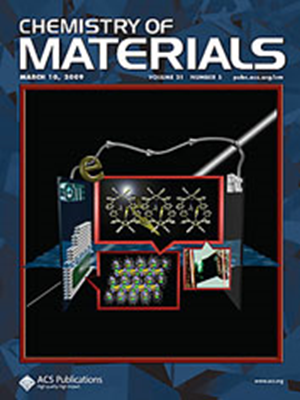Potassium– and Lithium–Ammonia Intercalation into Excitonic Insulator Candidate Ta2NiSe5
IF 7
2区 材料科学
Q2 CHEMISTRY, PHYSICAL
引用次数: 0
Abstract
Two new reduced phases derived from the topical excitonic insulator candidate Ta2NiSe5 have been synthesized via the intercalation of lithium and potassium from solutions of the metals in liquid ammonia. Li(NH3)Ta2NiSe5 and KTa2NiSe5 both crystallize in orthorhombic space group Pmnb with the following lattice parameters: a = 3.5175(1) Å, b = 18.7828(7) Å, and c = 15.7520(3) Å and a = 3.50247(3) Å, b = 13.4053(4) Å, and c = 15.7396(2) Å, respectively. They have increased unit cell volumes of 48% and 31%, respectively, relative to that of Ta2NiSe5. Significant rearrangement of the transition metal selenide layers is observed in both intercalates compared to the parent phase. In Li(NH3)Ta2NiSe5, neutron diffraction experiments confirm the location of the light Li, N, and H atoms, and solid-state nuclear magnetic resonance (NMR) experiments show that H, N, and Li each occupy a single environment at ambient temperature on the NMR time scale. Magnetometry data show that both intercalates have increased magnetic susceptibilities relative to that of Ta2NiSe5, consistent with the injection of electrons during intercalation and an enhancement of the Pauli paramagnetism.

激发绝缘体候选物质 Ta2NiSe5 中的钾氨和锂氨互嵌
通过锂和钾在液氨溶液中的插层作用,合成了两种新的还原相,它们都来自于候选激子绝缘体 Ta2NiSe5。Li(NH3)Ta2NiSe5 和 KTa2NiSe5 均在正交空间群 Pmnb 中结晶,晶格参数如下:a = 3.5175(1) Å,b = 18.7828(7) Å,c = 15.7520(3) Å;a = 3.50247(3) Å,b = 13.4053(4) Å,c = 15.7396(2) Å。与 Ta2NiSe5 相比,它们的单胞体积分别增加了 48% 和 31%。与母相相比,两种插层化合物中的过渡金属硒化物层都发生了显著的重排。在 Li(NH3)Ta2NiSe5 中,中子衍射实验证实了轻 Li、N 和 H 原子的位置,而固态核磁共振(NMR)实验则表明,在环境温度下,H、N 和 Li 在 NMR 时间尺度上各自占据一个环境。磁力测量数据显示,与 Ta2NiSe5 相比,两种插层材料的磁感应强度都有所提高,这与插层过程中电子的注入和保利顺磁的增强是一致的。
本文章由计算机程序翻译,如有差异,请以英文原文为准。
求助全文
约1分钟内获得全文
求助全文
来源期刊

Chemistry of Materials
工程技术-材料科学:综合
CiteScore
14.10
自引率
5.80%
发文量
929
审稿时长
1.5 months
期刊介绍:
The journal Chemistry of Materials focuses on publishing original research at the intersection of materials science and chemistry. The studies published in the journal involve chemistry as a prominent component and explore topics such as the design, synthesis, characterization, processing, understanding, and application of functional or potentially functional materials. The journal covers various areas of interest, including inorganic and organic solid-state chemistry, nanomaterials, biomaterials, thin films and polymers, and composite/hybrid materials. The journal particularly seeks papers that highlight the creation or development of innovative materials with novel optical, electrical, magnetic, catalytic, or mechanical properties. It is essential that manuscripts on these topics have a primary focus on the chemistry of materials and represent a significant advancement compared to prior research. Before external reviews are sought, submitted manuscripts undergo a review process by a minimum of two editors to ensure their appropriateness for the journal and the presence of sufficient evidence of a significant advance that will be of broad interest to the materials chemistry community.
 求助内容:
求助内容: 应助结果提醒方式:
应助结果提醒方式:


